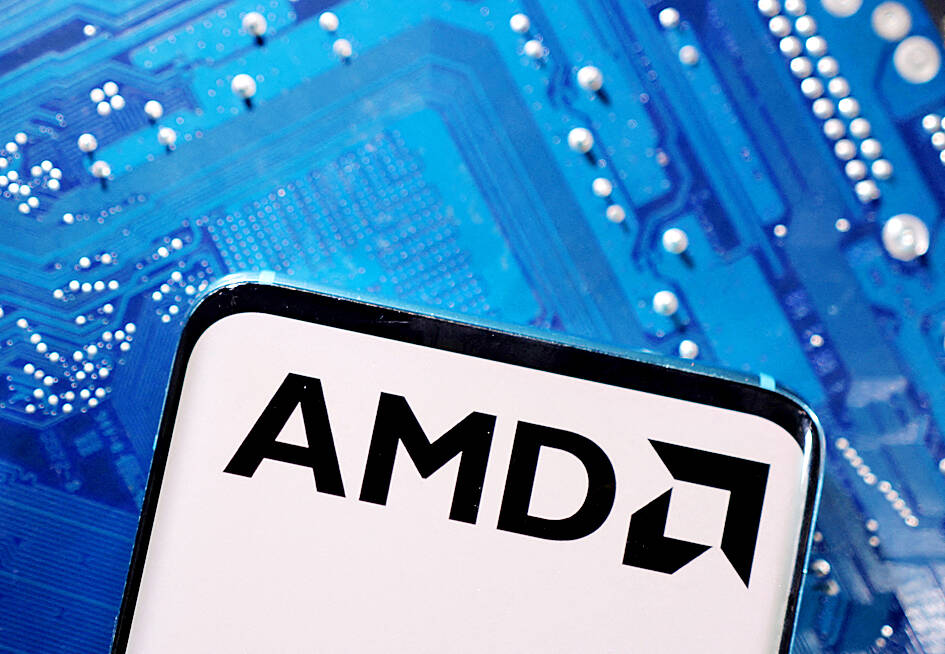Advanced Micro Devices Inc (AMD), Nvidia Corp’s closest rival in artificial intelligence (AI) processors, said that US restrictions on sales to China would cost US$1.5 billion in revenue this year, a warning that clouded an otherwise upbeat outlook.
The guidance stems from an export restriction imposed last month that targeted AMD’s MI308 chips, the company said during an earnings call on Tuesday.
Data center revenue would decline in the current period, hurt by a US$700 million reduction in sales of that product, AMD said.

Photo: REUTERS
Chief executive officer Lisa Su (蘇姿丰) remains bullish about overall demand for AI infrastructure. She also reiterated her projection that new chips debuting soon would help boost sales in the second half of the year. However, she is facing investor concerns about trade restrictions and tariffs, as well as the challenges of competing with Nvidia in the AI chip market.
“We’re excited about the overall AI business — I think we continue to see strength there,” Su said. “I know there are some uncertainties as it relates to tariffs and other things, but this is one of those areas where from an infrastructure standpoint, there continues to be investment in AI infrastructure. And so with that, we would expect strong growth into the second half of the year.”
Last month, AMD said it expected to record an expense of about US$800 million because of the new export rules.
Second-quarter sales are forecast to be about US$7.4 billion, the company said.
That compares with an average analyst estimate of US$7.23 billion.
AMD’s first-quarter sales rose 36 percent year-on-year to US$7.4 billion, topping the US$7.12 billion estimate. Profit was US$0.96 a share, minus certain items.
Revenue in the data center division was US$3.7 billion in the period, a gain of 57 percent from the same period a year earlier, while personal computer-
related sales climbed 28 percent to US$2.9 billion.
AMD is the second-biggest provider of graphics chips, which form the basis for the AI accelerators that run in data centers.
Nvidia chief executive officer Jensen Huang (黃仁勳) on Tuesday said that the market for AI chips in China could reach US$50 billion in the next couple of years, making it crucial for US companies to have access to the country.
“It would be a tremendous loss not to be able to address it as an American company,” Huang said in an interview on CNBC. “It’s going to bring back revenues. It’s going to bring back taxes. It’s going to create lots of jobs here in the United States.”
A recent increase in restrictions led Nvidia to book writedowns of US$5.5 billion related to its H20 product. That chip, a less powerful processor designed for the Chinese market, would now require special approval from regulators before it could be shipped to customers in that country.
“The best move is let Americans do American — let us go after it and win it,” he said, adding that the world is “hungry for AI. Let us get the American AI out in front of everybody right now.”

When Lika Megreladze was a child, life in her native western Georgian region of Guria revolved around tea. Her mother worked for decades as a scientist at the Soviet Union’s Institute of Tea and Subtropical Crops in the village of Anaseuli, Georgia, perfecting cultivation methods for a Georgian tea industry that supplied the bulk of the vast communist state’s brews. “When I was a child, this was only my mum’s workplace. Only later I realized that it was something big,” she said. Now, the institute lies abandoned. Yellowed papers are strewn around its decaying corridors, and a statue of Soviet founder Vladimir Lenin

UNIFYING OPPOSITION: Numerous companies have registered complaints over the potential levies, bringing together rival automakers in voicing their reservations US President Donald Trump is readying plans for industry-specific tariffs to kick in alongside his country-by-country duties in two weeks, ramping up his push to reshape the US’ standing in the global trading system by penalizing purchases from abroad. Administration officials could release details of Trump’s planned 50 percent duty on copper in the days before they are set to take effect on Friday next week, a person familiar with the matter said. That is the same date Trump’s “reciprocal” levies on products from more than 100 nations are slated to begin. Trump on Tuesday said that he is likely to impose tariffs

HELPING HAND: Approving the sale of H20s could give China the edge it needs to capture market share and become the global standard, a US representative said The US President Donald Trump administration’s decision allowing Nvidia Corp to resume shipments of its H20 artificial intelligence (AI) chips to China risks bolstering Beijing’s military capabilities and expanding its capacity to compete with the US, the head of the US House Select Committee on Strategic Competition Between the United States and the Chinese Communist Party said. “The H20, which is a cost-effective and powerful AI inference chip, far surpasses China’s indigenous capability and would therefore provide a substantial increase to China’s AI development,” committee chairman John Moolenaar, a Michigan Republican, said on Friday in a letter to US Secretary of

ELECTRONICS BOOST: A predicted surge in exports would likely be driven by ICT products, exports of which have soared 84.7 percent from a year earlier, DBS said DBS Bank Ltd (星展銀行) yesterday raised its GDP growth forecast for Taiwan this year to 4 percent from 3 percent, citing robust demand for artificial intelligence (AI)-related exports and accelerated shipment activity, which are expected to offset potential headwinds from US tariffs. “Our GDP growth forecast for 2025 is revised up to 4 percent from 3 percent to reflect front-loaded exports and strong AI demand,” Singapore-based DBS senior economist Ma Tieying (馬鐵英) said in an online briefing. Taiwan’s second-quarter performance beat expectations, with GDP growth likely surpassing 5 percent, driven by a 34.1 percent year-on-year increase in exports, Ma said, citing government